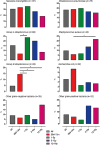Mortality and morbidity in community-acquired sepsis in European pediatric intensive care units: a prospective cohort study from the European Childhood Life-threatening Infectious Disease Study (EUCLIDS)
- PMID: 29855385
- PMCID: PMC5984383
- DOI: 10.1186/s13054-018-2052-7
Mortality and morbidity in community-acquired sepsis in European pediatric intensive care units: a prospective cohort study from the European Childhood Life-threatening Infectious Disease Study (EUCLIDS)
Abstract
Background: Sepsis is one of the main reasons for non-elective admission to pediatric intensive care units (PICUs), but little is known about determinants influencing outcome. We characterized children admitted with community-acquired sepsis to European PICUs and studied risk factors for mortality and disability.
Methods: Data were collected within the collaborative Seventh Framework Programme (FP7)-funded EUCLIDS study, which is a prospective multicenter cohort study aiming to evaluate genetic determinants of susceptibility and/or severity in sepsis. This report includes 795 children admitted with community-acquired sepsis to 52 PICUs from seven European countries between July 2012 and January 2016. The primary outcome measure was in-hospital death. Secondary outcome measures were PICU-free days censured at day 28, hospital length of stay, and disability. Independent predictors were identified by multivariate regression analysis.
Results: Patients most commonly presented clinically with sepsis without a source (n = 278, 35%), meningitis/encephalitis (n = 182, 23%), or pneumonia (n = 149, 19%). Of 428 (54%) patients with confirmed bacterial infection, Neisseria meningitidis (n = 131, 31%) and Streptococcus pneumoniae (n = 78, 18%) were the main pathogens. Mortality was 6% (51/795), increasing to 10% in the presence of septic shock (45/466). Of the survivors, 31% were discharged with disability, including 24% of previously healthy children who survived with disability. Mortality and disability were independently associated with S. pneumoniae infections (mortality OR 4.1, 95% CI 1.1-16.0, P = 0.04; disability OR 5.4, 95% CI 1.8-15.8, P < 0.01) and illness severity as measured by Pediatric Index of Mortality (PIM2) score (mortality OR 2.8, 95% CI 1.3-6.1, P < 0.01; disability OR 3.4, 95% CI 1.8-6.4, P < 0.001).
Conclusions: Despite widespread immunization campaigns, invasive bacterial disease remains responsible for substantial morbidity and mortality in critically ill children in high-income countries. Almost one third of sepsis survivors admitted to the PICU were discharged with some disability. More research is required to delineate the long-term outcome of pediatric sepsis and to identify interventional targets. Our findings emphasize the importance of improved early sepsis-recognition programs to address the high burden of disease.
Keywords: Bacteremia; Meningococcal infections; Morbidity; Mortality; Pneumococcal infections.
Conflict of interest statement
Ethics approval and consent to participate
This study was conducted in accordance with the Declaration of Helsinki and Good Clinical Practice guidelines. The study protocol was approved by at least one ethical review board in every country (Coordinating center Research Ethics Committee reference: 11/LO/1982).
Consent for publication
Written informed consent was obtained from parents or legal guardians. In the Swiss study, consent was obtained if feasible, but collection of anonymized epidemiological data was approved for all patients. All authors have provided consent for publication of the manuscript.
Competing interests
The authors declare that they have no competing interests
Publisher’s Note
Springer Nature remains neutral with regard to jurisdictional claims in published maps and institutional affiliations.
Figures


References
-
- Weiss SL, Fitzgerald JC, Pappachan J, Wheeler D, Jaramillo-Bustamante JC, Salloo A, Singhi SC, Erickson S, Roy JA, Bush JL, et al. Global epidemiology of pediatric severe sepsis: the sepsis prevalence, outcomes, and therapies study. Am J Respir Crit Care Med. 2015;191(10):1147–1157. doi: 10.1164/rccm.201412-2323OC. - DOI - PMC - PubMed
-
- Schlapbach LJ, Straney L, Alexander J, MacLaren G, Festa M, Schibler A, Slater A, Group APS Mortality related to invasive infections, sepsis, and septic shock in critically ill children in Australia and New Zealand, 2002-13: a multicentre retrospective cohort study. Lancet Infect Dis. 2015;15(1):46–54. doi: 10.1016/S1473-3099(14)71003-5. - DOI - PubMed
Publication types
MeSH terms
Grants and funding
- 279185/European Seventh Framework Programme for Research and Technological Development (FP7)/International
- 342730_153158/1/Swiss National Science Foundation/Switzerland
- N/A/Swiss Society of Intensive Care/International
- N/A/Bangerter Foundation/International
- N/A/Vinetum and Borer Foundation/International
LinkOut - more resources
Full Text Sources
Other Literature Sources
Medical

